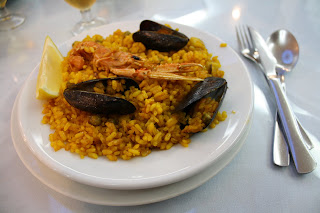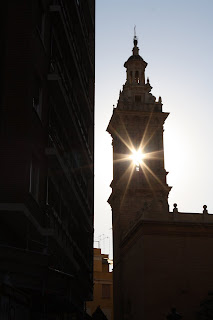Valencia is the third largest city in Spain, yet it doesn't feel like it. Walking through its streets, Valencia has neither the massive expanse or looming buildings that often characterize a large city. Instead it feels more like a town with few crowds, friendly buildings, and a pace of life that won't stress you out.

For many travelers, a visit to Valencia might be a bit more off the beaten path. Our reasons for coming to Valencia? Well, it is the birthplace of paella and its cathedral contains the Holy Grail. We were pleasantly surprised to discover such a beautiful city, including expansive squares with beautiful fountains.

Paella is a traditional Spanish dish that combines rice with local seafood or meat and vegetables. It is a tasty treat worth sampling. Plus, for those grandparents worried that we aren't eating, we thought this picture might help calm your fears.

Valencia's cathedral was built over a mosque in the thirteenth century, and it contains numerous examples of Gothic art and architecture.

This bizarre find is actually the withered arm of St. Vincent, a Dominican missionary who was born in Valencia in the mid-1300s. We're not sure exactly how he died, or how Valencia's cathedral came to acquire his arm, but nonetheless it is certainly displayed proudly.

Portions of the cathedral have been built and rebuilt at different times over the past several hundred years, and in this picture, you can see two different styles still present today. In addition to the Gothic style, there are also examples of Renaissance, Baroque, and Romanesque influences, indicative of the many different influences throughout history on the region.

Ceilings are often under-appreciated in both beauty and ability as teaching tools. For example, how many lines of reflective symmetry are there? What is the rotational symmetry order of the ceiling? How many ways can you curse Justin's name?

The big attraction of the chapel is the Holy Grail. Indiana Jones was chased by Nazis all over the place looking for this thing and it was here, in a big case with its own room all along.

No, it's not a still shot from
Monty Python and the Holy Grail. It's the stained glass located right above the Holy Grail.

And there it is, the chalice believed to be used by Jesus at the Last Supper and the only one recognized by the Vatican (there are two additional chalices believed to be contenders for the title: one in Jerusalem and another in Genoa, Italy). The cup is made of red agate and according to scientists, dates back to the 1st century AD. It is believed that this particular chalice was carried by St. Peter to Rome, where it was then entrusted to the care of popes until it was sent to Spain for safekeeping. Wonder if we scrap the edge a little, we could find some old Jesus skin cells we could use to clone Jesus. Probably not the second coming Christ had in mind...

You go and build a nice little castle wall, and then someone has to come along with their cannons and put a bunch of holes in it. Now ain't that a pain?

Churros are another traditional Spanish food, and a delicious one at that. Churros are a kind of fried dough, like a doughnut, sometimes covered in cinnamon and sugar, although we ate ours with a wonderfully rich, thick chocolate.

Careful, don't look directly into this photo. It might burn your retinas!

In Spain this time of year, the sun doesn't set until 9 pm, and there's still more than a month until the summer solstice. Apparently not even the moon can wait for the sun to set...
More to come on our travels in Spain!



















































